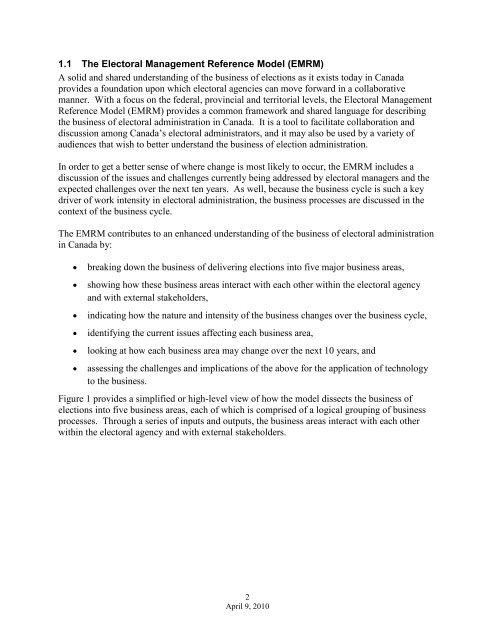Electoral-Management-Reference-Model-v.1.0
Electoral-Management-Reference-Model-v.1.0
Electoral-Management-Reference-Model-v.1.0
Create successful ePaper yourself
Turn your PDF publications into a flip-book with our unique Google optimized e-Paper software.
1.1 The <strong>Electoral</strong> <strong>Management</strong> <strong>Reference</strong> <strong>Model</strong> (EMRM)<br />
A solid and shared understanding of the business of elections as it exists today in Canada<br />
provides a foundation upon which electoral agencies can move forward in a collaborative<br />
manner. With a focus on the federal, provincial and territorial levels, the <strong>Electoral</strong> <strong>Management</strong><br />
<strong>Reference</strong> <strong>Model</strong> (EMRM) provides a common framework and shared language for describing<br />
the business of electoral administration in Canada. It is a tool to facilitate collaboration and<br />
discussion among Canada’s electoral administrators, and it may also be used by a variety of<br />
audiences that wish to better understand the business of election administration.<br />
In order to get a better sense of where change is most likely to occur, the EMRM includes a<br />
discussion of the issues and challenges currently being addressed by electoral managers and the<br />
expected challenges over the next ten years. As well, because the business cycle is such a key<br />
driver of work intensity in electoral administration, the business processes are discussed in the<br />
context of the business cycle.<br />
The EMRM contributes to an enhanced understanding of the business of electoral administration<br />
in Canada by:<br />
• breaking down the business of delivering elections into five major business areas,<br />
• showing how these business areas interact with each other within the electoral agency<br />
and with external stakeholders,<br />
• indicating how the nature and intensity of the business changes over the business cycle,<br />
• identifying the current issues affecting each business area,<br />
• looking at how each business area may change over the next 10 years, and<br />
• assessing the challenges and implications of the above for the application of technology<br />
to the business.<br />
Figure 1 provides a simplified or high-level view of how the model dissects the business of<br />
elections into five business areas, each of which is comprised of a logical grouping of business<br />
processes. Through a series of inputs and outputs, the business areas interact with each other<br />
within the electoral agency and with external stakeholders.<br />
2<br />
April 9, 2010


